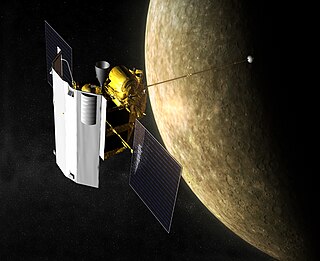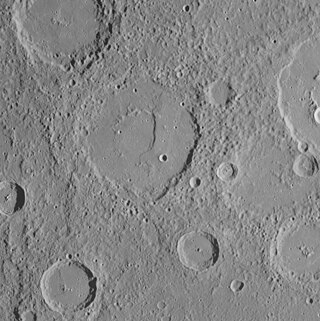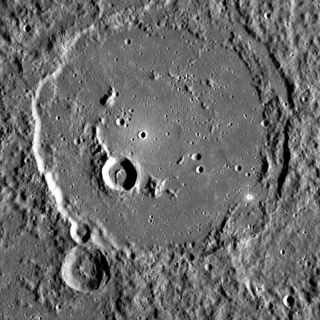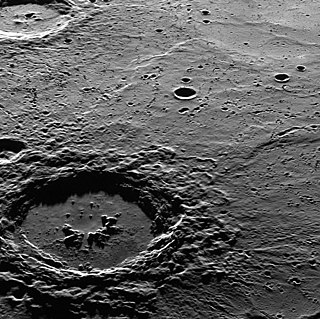
Mercury is the first planet from the Sun and the smallest in the Solar System. In English, it is named after the ancient Roman god Mercurius (Mercury), god of commerce and communication, and the messenger of the gods. Mercury is classified as a terrestrial planet, with roughly the same surface gravity as Mars. The surface of Mercury is heavily cratered, as a result of countless impact events that have accumulated over billions of years. Its largest crater, Caloris Planitia, has a diameter of 1,550 km (960 mi), which is about one-third the diameter of the planet. Similarly to the Earth's Moon, Mercury's surface displays an expansive rupes system generated from thrust faults and bright ray systems formed by impact event remnants.

MESSENGER was a NASA robotic space probe that orbited the planet Mercury between 2011 and 2015, studying Mercury's chemical composition, geology, and magnetic field. The name is a backronym for Mercury Surface, Space Environment, Geochemistry, and Ranging, and a reference to the messenger god Mercury from Roman mythology.

Tir Planitia is a large plain on the planet Mercury. The name Tir (تیر) is the Persian word for "Mercury", and the name was approved in 1976. It was first observed in detail by Mariner 10. It lies between the large crater Mozart and the ancient Tolstoj basin.

The Eminescu quadrangle (H-9) is one of fifteen quadrangles on Mercury. It runs from 216 to 288° longitude and from -25 to 25° latitude. Named after the Eminescu crater, it was mapped in detail for the first time after MESSENGER entered orbit around Mercury in 2011. It had not been mapped prior to that point because it was one of the six quadrangles that was not illuminated when Mariner 10 made its flybys in 1974 and 1975. These six quadrangles continued to be known by their albedo feature names, with this one known as the Solitudo Criophori quadrangle.

The Debussy quadrangle (H-14) is one of fifteen quadrangles on Mercury. It runs from 270 to 360° longitude and from -20 to -70° latitude. Named after the Debussy crater, it was mapped in detail for the first time after MESSENGER entered orbit around Mercury in 2011. It had not been mapped prior to that point because it was one of the six quadrangles that was not illuminated when Mariner 10 made its flybys in 1974 and 1975. These six quadrangles continued to be known by their albedo feature names, with this one known as the Cyllene quadrangle.

The Neruda quadrangle (H-13) is one of fifteen quadrangles on Mercury. It runs from 180 to 270° longitude and -20 to -70° latitude. Named after the Neruda crater, it was mapped in detail for the first time after MESSENGER entered orbit around Mercury in 2011. It had not been mapped prior to that point because it was one of the six quadrangles that was not illuminated when Mariner 10 made its flybys in 1974 and 1975. These six quadrangles continued to be known by their albedo feature names, with this one known as the Solitudo Persephones quadrangle.

Boethius is a crater on the planet Mercury. It was named after Anicius Manlius Severinus Boethius, the Roman philosopher, by the IAU in 1976. The crater was first imaged by Mariner 10 in 1974.

Raphael is a crater on Mercury. Its name was adopted by the International Astronomical Union (IAU) in 1976, and is named for the Italian painter Raphael. It is Tolstojan in age. The crater was first imaged by Mariner 10 in 1974.

Verdi is an impact crater on the planet Mercury. It was named after Italian Romantic composer Giuseppe Verdi (1813–1901) in 1979, as recognized by the International Astronomical Union. The crater's extensive ejecta blanket and secondary crater field are superposed on plains materials and older craters.

Polygnotus is a crater on Mercury, named by the IAU in 1976, after ancient Greek painter Polygnotus. The crater was first imaged by Mariner 10 in 1974.

The crater Oskison is located in the far northern hemisphere of Mercury, in the plains north of Caloris basin. Oskison is a distinctive crater with a large central peak that exposes material excavated from depth. Many chains of secondary craters are visible radiating from Oskison outward onto the surrounding smooth plains, known as Stilbon Planitia.

Hokusai is a rayed impact crater on Mercury, which was discovered in 1991 by ground-based radar observations conducted at Goldstone Observatory. The crater was initially known as feature B. Its appearance was so dissimilar to other impact craters that it was once thought to be a shield volcano. However, improved radar images by the Arecibo Observatory obtained later in 2000–2005 clearly showed that feature B is an impact crater with an extensive ray system. The bright appearance of rays in the radio images indicates that the crater is geologically young; fresh impact ejecta has a rough surface, which leads to strong scattering of radio waves.

Balzac is a crater on Mercury. Its name was adopted by the International Astronomical Union in 1976. Balzac is named for the French writer Honoré de Balzac, who lived from 1799 to 1850. The crater was first imaged by Mariner 10 in 1974.

Futabatei is a crater on Mercury. It has a diameter of 57 kilometers. Its name was adopted by the International Astronomical Union in 1976. Futabatei is named for the Japanese novelist Futabatei Shimei, who lived from 1864 to 1909. The crater was first imaged by Mariner 10 in 1974.

Janáček is a crater on Mercury. It has a diameter of 47 kilometers. Its name was adopted by the International Astronomical Union (IAU) in 1985. Janáček is named for the Czech composer Leoš Janáček, who lived from 1854 to 1928. The MESSENGER Mercury orbiter crashed near the crater on 30 April 2015.

Machaut is a crater on Mercury. Its name was adopted by the International Astronomical Union in 1976. Machaut is named for the French composer and poet Guillaume de Machaut, who lived from 1300 to 1377. The crater was first imaged by Mariner 10 in 1974.

A permanently shadowed crater is a depression on a body in the Solar System within which lies a point that is always in darkness.

Tyagaraja is a crater on Mercury. Its name was adopted by the International Astronomical Union in 1976. Tyagaraja is named for the Indian composer Tyagaraja. The crater was first imaged by Mariner 10 in 1974.

Zeami is a crater on Mercury. Its name was adopted by the International Astronomical Union in 1976, after the Japanese dramatist and playwright Zeami Motokiyo.

Flaiano is a crater on Mercury. It has a diameter of 43 kilometres. Its name was adopted by the International Astronomical Union (IAU) on March 15, 2013. Flaiano is named for the Italian writer Ennio Flaiano. The crater was first imaged by Mariner 10 in 1974.





















